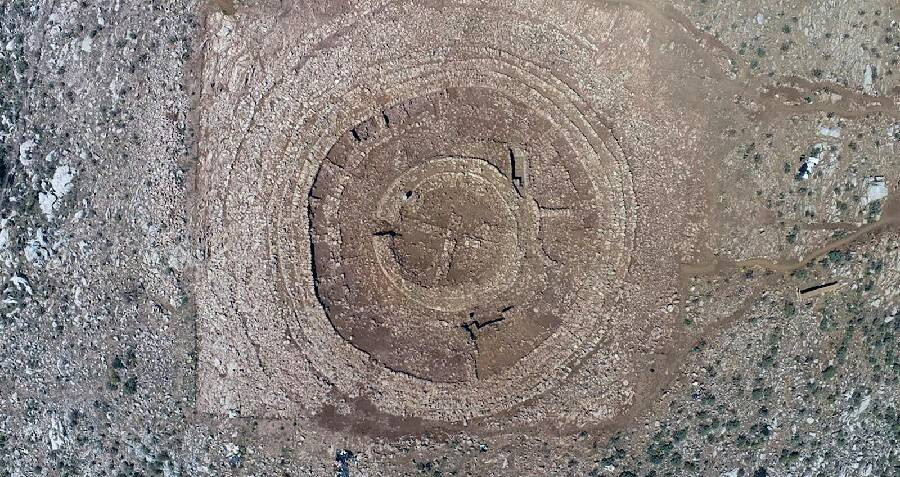An Unprecedented Find in Minoan Archaeology
Ongoing excavations on Papoura Hill, near the site of a new airport runway in Kastelli, have unveiled an extraordinary piece of Minoan history. A circular architectural complex, unique in its scale and design, has come to light, offering insights into the engineering prowess and cultural practices of the ancient Minoans. Spanning approximately 1800 square meters with a diameter of 48 meters, this structure represents an unprecedented find in Minoan archaeology.

Architectural Intricacies
The monumental complex is composed of eight concentric stone rings, each averaging 1.40 meters in thickness and reaching a maximum estimated height of 1.7 meters. These rings are arranged across varying elevation levels, showcasing advanced construction techniques.
At the heart of the structure lies Zone A, a circular building with a 15-meter diameter. Its corbelled masonry design divides it into four quadrants. Surrounding Zone A is Zone B, a broader circular space with a maximum width of 6.9 meters. Radial walls intersect the concentric rings at lower levels, creating smaller interconnected spaces linked by narrow openings.

A Glimpse into the Past
Historical Context
Archaeological evidence suggests the complex dates to the period between 2000 and 1700 BCE, aligning with the early stages of the Protopalatial period (Middle Minoan I–II). Pottery fragments from the Neopalatial period found within the destruction layer indicate the site remained in use even after the emergence of the new palaces, hinting at its enduring importance.
Ritual and Communal Significance
Artifacts and animal bones uncovered at the site suggest its primary function was not residential but ritualistic. This monumental structure likely served as a venue for periodic communal events involving food, wine, and offerings. The sheer size, architectural complexity, and meticulous craftsmanship underscore the presence of centralized authority and specialized labor, signifying its role as a communal landmark in the Pediada region.
Preserving a Unique Heritage
Official Inspection and Future Plans
The discovery has drawn the attention of Greek authorities, including Minister of Culture Lina Mendoni and Deputy Minister of Infrastructure and Transport Nikos Tachiaos. A comprehensive site inspection was conducted to assess how to balance the archaeological significance of the find with the ongoing airport construction.
Minister Mendoni emphasized the importance of preserving the monument, describing it as a “unique find of exceptional interest.” She assured that archaeological research would continue to protect and interpret the site, highlighting the monument’s importance to cultural heritage.
Balancing Development and Cultural Preservation
Efforts are underway to identify an alternative location for the airport radar to safeguard the site. The Civil Aviation Authority will submit a new study to the Ministry of Culture to ensure the project progresses without compromising the integrity of the archaeological discovery.

Ongoing Excavations and Future Insights
As excavations continue, researchers are working to uncover the original form and full height of the complex. This process is critical to understanding the monument’s character and its connections to contemporary residential and religious centers in the Pediada area.
The unprecedented nature of this find cements its status as a landmark, not only for the history of the region but also for the new Heraklion Airport. Future discoveries at the site promise to deepen our understanding of the Minoan civilization and its architectural and cultural achievements.

